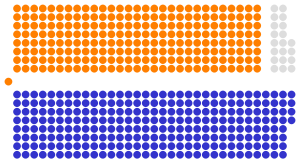1705 English General Election
The 1705 English general election saw contests in 110 constituencies in England and Wales, roughly 41% of the total.
The election was fiercely fought, with mob violence and cries of "Church in Danger" occurring in several boroughs. During the previous session of Parliament the Tories had become increasingly unpopular, and their position was therefore somewhat weakened by the election, particularly by the Tackers controversy. Due to the uncertain loyalty of a group of 'moderate' Tories led by Robert Harley, the parties were roughly balanced in the House of Commons following the election, encouraging the Whigs to demand a greater share in the government led by Marlborough
| ||||||||||||||||
All 513 seats in the House of Commons 257 seats needed for a majority | ||||||||||||||||
|---|---|---|---|---|---|---|---|---|---|---|---|---|---|---|---|---|
| ||||||||||||||||
 House of Commons after election (Whigs-orange, Tories-blue) | ||||||||||||||||

Summary of the constituencies
See 1796 British general election for details. The constituencies used in England and Wales were the same throughout the period. In 1707 alone the 45 Scottish members were not elected from the constituencies, but were returned by co-option in a part of the membership of the last Parliament of Scotland elected before the Acts of Union 1707.
Party strengths are an approximation, with many MPs' allegiances being unknown.
Involved parties
In 1705 the House of Commons was controlled by two parties: the Tory party led by John Churchill, Duke of Marlborough, and the Whig party led by a group of leading party members known as the Whig Junto. The four members of the Whig Junto were John Somers, Charles Montagu, Thomas Wharton, and Edward Russell.
Overview of 18th-century British politics
The politics of Britain in 1705 was chaotic. The government was very decentralized and led to unrest in the general population. This led to the mob violence that occurred during this election process across the country.
See also
References
- Cruickshanks, Eveline; Handley, Stuart; Hayton, David, eds. (2002), The House of Commons, 1690–1715, The History of Parliament, Cambridge: Cambridge University Press
External links
This article uses material from the Wikipedia English article 1705 English general election, which is released under the Creative Commons Attribution-ShareAlike 3.0 license ("CC BY-SA 3.0"); additional terms may apply (view authors). Content is available under CC BY-SA 4.0 unless otherwise noted. Images, videos and audio are available under their respective licenses.
®Wikipedia is a registered trademark of the Wiki Foundation, Inc. Wiki English (DUHOCTRUNGQUOC.VN) is an independent company and has no affiliation with Wiki Foundation.

